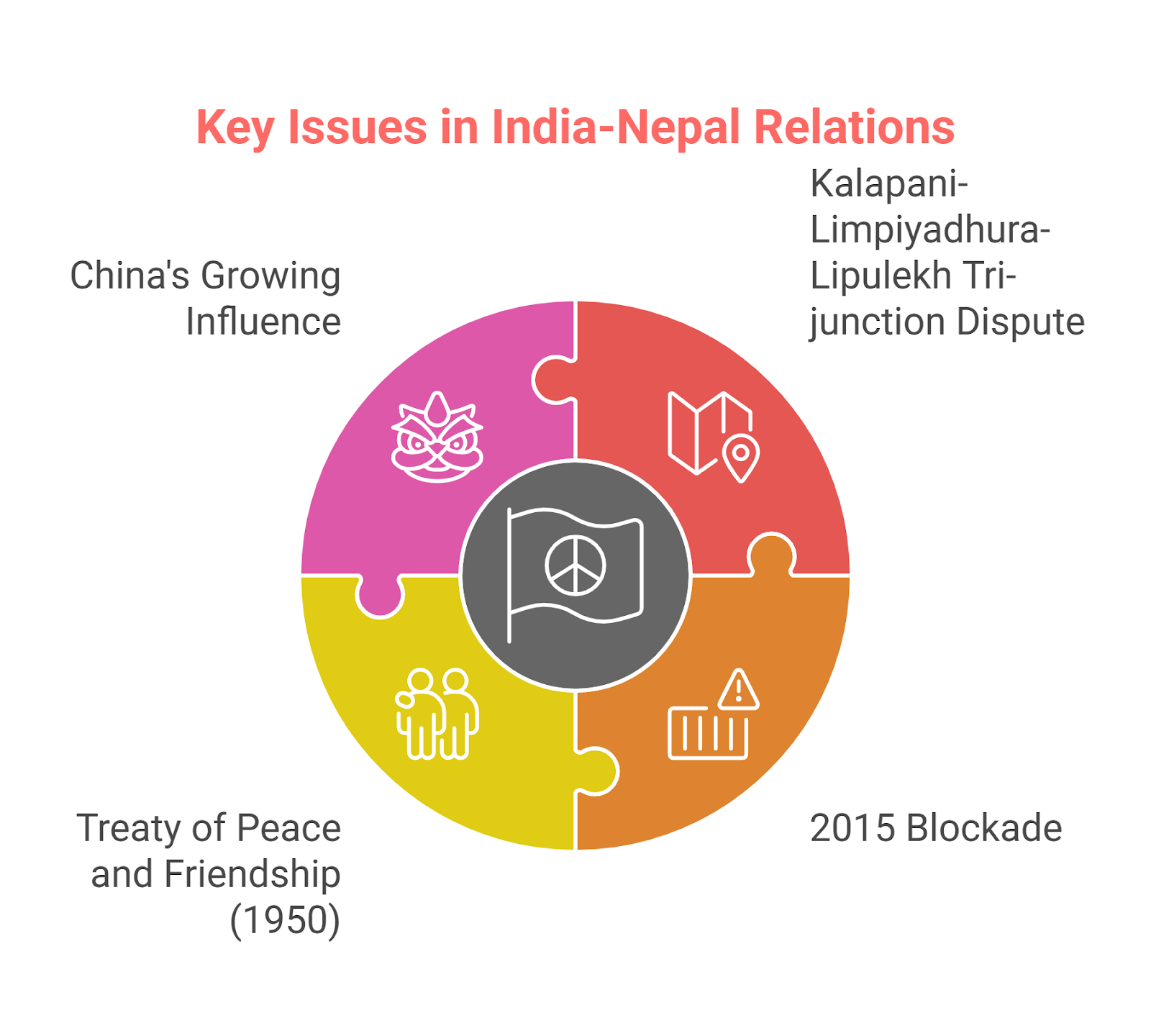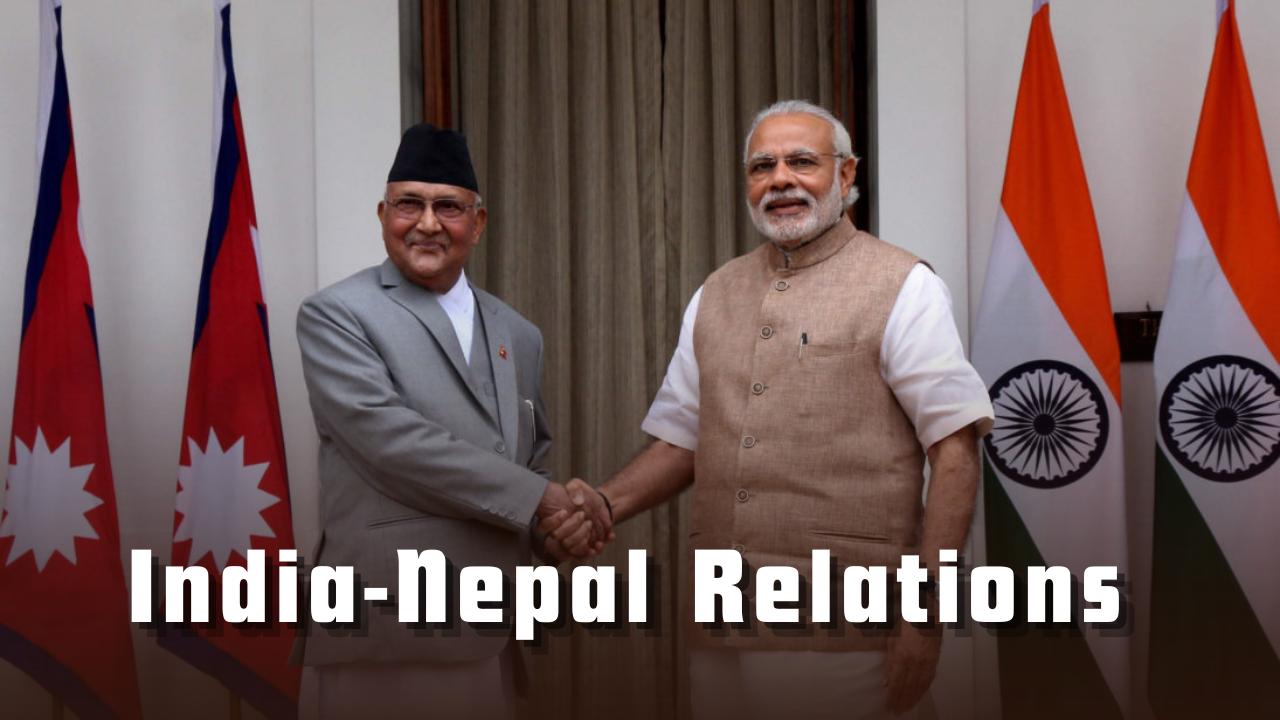Font size:
Print
India-Nepal Relations
India-Nepal Relations: India and Nepal are experiencing a discernible warming of relations ahead of Nepalese Prime Minister K.P. Sharma Oli’s anticipated visit to New Delhi.
More on News
- This will be his first trip to India since taking office, a notable departure from the tradition where Nepalese leaders typically make New Delhi their first port of call.
- The engagement builds on recent cooperation, contrasting sharply with the significant strains witnessed during Oli’s previous term, which were marked by a bitter border dispute and a strong anti-India rhetoric.
What are the new areas of cooperation between India and Nepal?
The bilateral relationship is expanding beyond traditional areas into new, strategic domains that build people-to-people connectivity and modernise cooperation:
- Defence and Security Modernisation: Beyond general support, India’s recent handing over of specialised military equipment, medical supplies, and trained dogs and horses points to a focus on enhancing the Nepalese Army’s counter-insurgency, disaster response, and border patrol capabilities. This is a tangible upgrade in security partnership.
- Crisis Response and Evacuation Cooperation: Operation Sindhu established a new template for cooperation, where India successfully evacuated Nepalese citizens from a conflict zone (Iran).
- This builds immense goodwill and positions India as a reliable first responder for Nepalese nationals abroad, a role traditionally not emphasised.
- Sports Diplomacy (Cricket): India’s initiative to host the Nepal Men’s National Cricket Team for a high-performance training camp at the BCCI’s premier National Cricket Academy is a masterstroke.
- It taps into cricket’s growing popularity in Nepal, engages the youth, and builds soft power in a domain with massive public appeal, creating a strong positive sentiment.
- Sub-National Engagement: The discussion on improved coordination at the district level between officials indicates a move to decentralise the relationship, address local issues more effectively, and strengthen the institutional framework of cross-border management beyond the federal capitals.

How can recent agreements and cooperation address challenges in India-Nepal relations?
The recent flurry of cooperation is strategically designed to build a buffer of goodwill that can help manage, if not immediately resolve, the core contentious issues:
- Creating a Positive Narrative: Initiatives like cricket diplomacy and crisis evacuation generate powerful positive public opinion in Nepal.
- This creates a counter-narrative to the anti-India sentiment fueled by the blockade and border disputes, making it harder for politicians to weaponise anti-India rhetoric without a domestic cost.
- Demonstrating Reliability vs. Strategic Assertion: By being the first to provide defence and humanitarian support, India positions itself as a reliable, generous partner.
- This is a soft-power contrast to China’s primarily economic and infrastructure-focused engagement, reminding Nepal of the multifaceted and historic nature of its ties with India.
- Building Interdependence: Enhancing security cooperation and training creates institutional linkages between the militaries and bureaucracies of both countries.
- This deepens interdependence and establishes channels of communication that can remain open even during political spats, acting as a stabiliser in the relationship.
- Separating the Solvable from the Intractable: The strategy appears to be to aggressively pursue cooperation in non-contentious areas like development projects, connectivity (rails, pipelines), and cultural ties.
- Success in these fields builds trust and creates a store of goodwill that can then be used to foster a more conducive environment for eventually tackling the more intractable political issues, like the border dispute, through quiet diplomacy.
Subscribe to our Youtube Channel for more Valuable Content – TheStudyias
Download the App to Subscribe to our Courses – Thestudyias
The Source’s Authority and Ownership of the Article is Claimed By THE STUDY IAS BY MANIKANT SINGH




